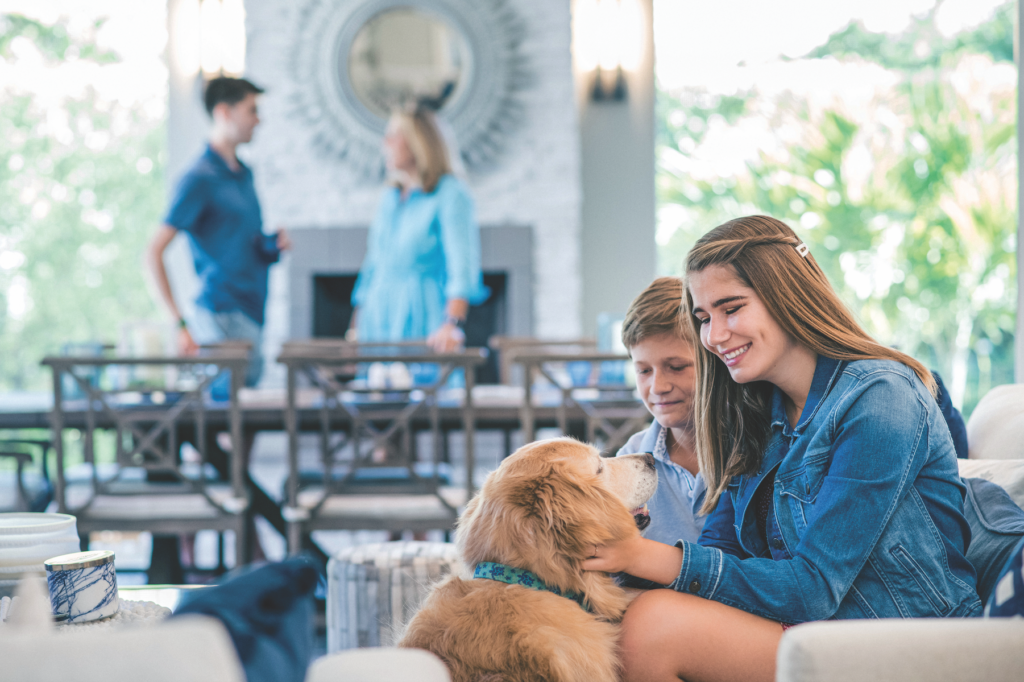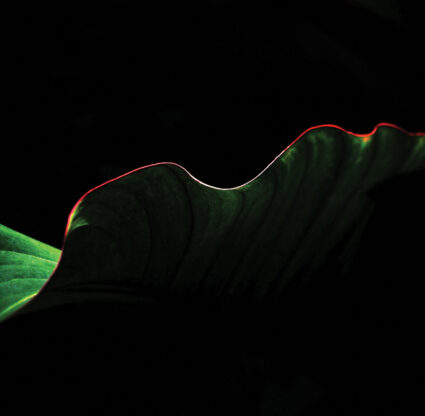It started off slowly. Achy muscles here, losing steam in a sprint there.
At the time, Heloise Hoffmann was a 10-year-old in a sports-crazy Dallas suburb. A promising tennis player, she was also deeply into another favorite Texas pastime—horseback riding. “Feeling the impact of the ball hitting my racquet or the wind whipping my hair was all the joy I could find in the world,” Heloise recalls.
But little by little more troubling signs started to appear. In matches, she might inexplicably fall down on the court or one of her shoulders would noticeably droop. It progressed to where, by the second set, she couldn’t escape the feeling of being blocked—out of gas, her legs giving out, and she knew she couldn’t possibly run as fast as she had half an hour before.
At the barn, if she was thrown from her horse, her shoulders might stay out of joint not just for a few days but for weeks. Once she developed splitting headaches and chronic pain, she knew something had to be wrong.

She and her family consulted medical professionals thinking the issue was orthopedic in nature, but without really knowing what was going on. It turned into a three-year odyssey to track down the mystery of how this seemingly healthy girl could be experiencing debilitating symptoms. One pediatric neurologist—in an act of cruelty that cut so deep it still reverberates today—told Heloise it was the fabrication of an overactive teenage mind. That person, who had exhausted all the testing she could do, referred them to another pediatric neurologist in Dallas who specialized in neuromuscular medicine and finally solved the puzzle.
On Valentine’s Day in 2017, when Heloise was in seventh grade, her parents, Alex and Anne Hoffmann, received a phone call while on a rare romantic rendezvous: Their daughter had facioscapulohumeral muscular dystrophy, commonly called FSHD, a type of muscular dystrophy caused by a rare genetic disorder.
They waited a couple weeks to tell Heloise, wanting to make sure they were knowledgeable enough to deliver the news and answer the questions she would undeniably have without choking up. “When my parents told me about my diagnosis, I visualized my life as a piece of glass being shattered over and over,” Heloise, now 17 years old and a senior at Community School of Naples, says. “It was as if someone was throwing a wrecking ball at this beautiful piece of stained glass. I zoned out and picked out words: ‘muscles deteriorating,’ ‘no cure,’ ‘no treatment.’ My muscles are dying. What is going on?”

FSHD is quite rare, appearing in only around 1 in 8,000 births. The vast majority of patients with FSHD can trace a hereditary path, but in Heloise’s case, after genetic testing, they found hers was caused by a spontaneous mutation of the DUX4 gene, which causes it to release a protein that’s toxic to her muscles.
For patients with FSHD, the muscles primarily affected are those in the upper body (the face, neck, shoulders, arms), but it can also affect the entire body. Although statistically, 20% of patients are in a wheelchair by age 50, there is no one linear progression: How quickly a patient loses function of various muscle groups and which abilities vanish differs case by case. “FSHD is a disorder that steals—it steals playing sports, dancing in a musical, brushing your hair. It always requires adaptation. She recently switched from taking notes in class via hand to now with an iPad,” says Anne, explaining that this will conserve and extend the energy in her shoulders and hands. “It’s emotional thinking ‘Am I disabled?’ I like to tell her, ‘You are uniquely abled.’”
Adjustments. It’s a concept heard often in the Hoffmann household. How one handles challenges and disappointments and adapts to a new situation is arguably what defines us as people, but for Heloise it is necessary for survival.
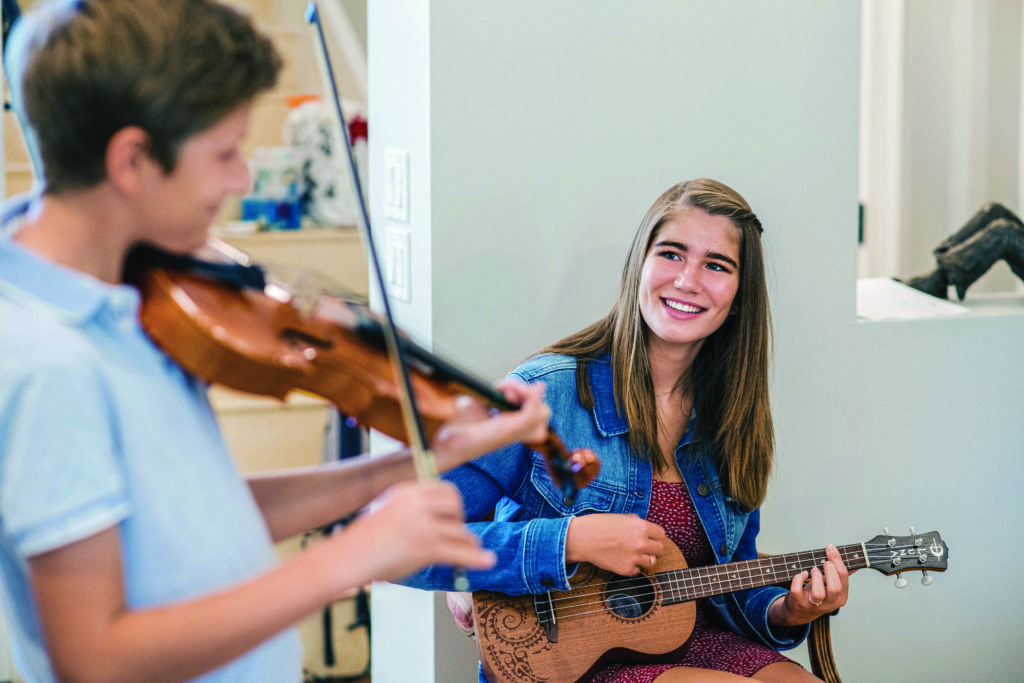
She quit tennis and horseback riding soon after her diagnosis and found an alternative universe in music and theater, performing in school shows and playing guitar and singing in a six-person pop-rock band, but even that hasn’t been without challenges. She picked up the clarinet, only to have to drop it a few years later because it was too taxing to hold up the instrument for long stretches of time.
Every day, she navigates a delicate balancing act: performing the light physical activity, such as walking or biking, she needs for cardiovascular benefits, and not overexerting or straining her muscles in fear of accelerating their deterioration.
“We are blessed that she has many talents,” Alex says. “She was able to rebound from sports—she’s creative and academic. We have nurtured her with these talents. We have helped her build self-confidence and resilience. But there is still uncertainty for us, and there are still moments where she needs physical and mental support.”
Heloise and her parents recall how she retreated from the world the first few months after her diagnosis as the reality set in. Middle school is hard enough for most; to have a heavy diagnosis weighing on her already-too-fragile shoulders, was unbearable. She built a shell around herself, not wanting to talk about FSHD, minimizing, ignoring and denying it.
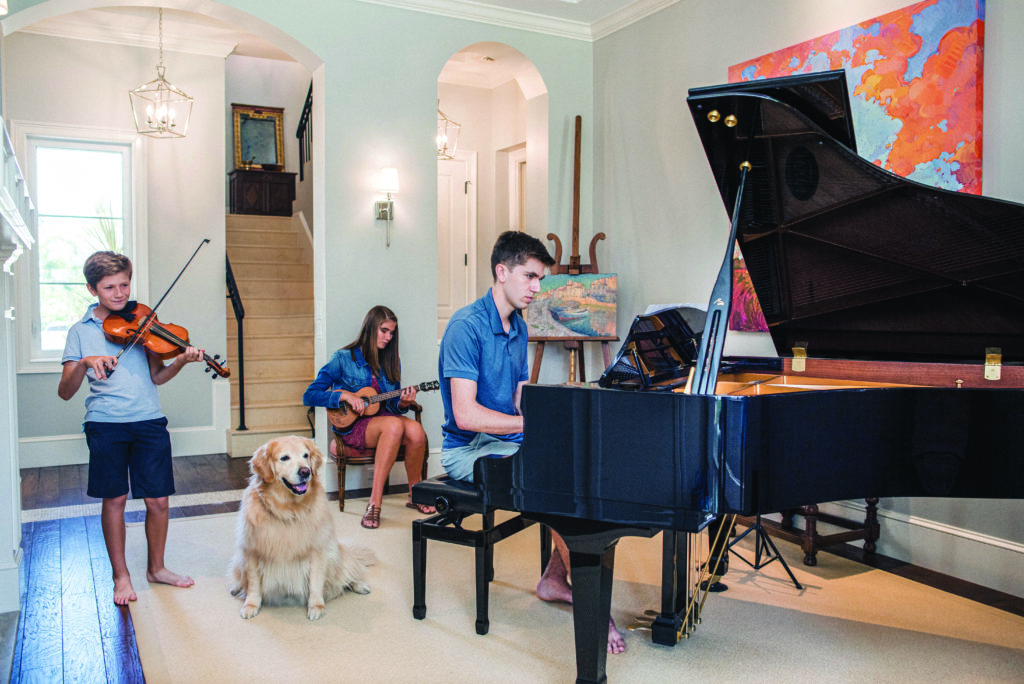
Supporting her through that time was her big, brilliant family, who continue to surround her with optimism and love. In addition to Alex, an executive in the fintech industry, who has helped build companies such as PayPal and MoneyGram, and Anne, a former corporate lawyer in their native Belgium, Heloise has three siblings: Guillaume, 20, Felicie, 15, and Harold, 11, who are all exceptional students and human beings in their own right.
Guillaume is a junior at Yale University where he’s studying biomedical engineering, a decision Anne and Alex undoubtedly believe was influenced by his sister’s experience. He was her rock through much of her early struggle, and to this day he is always the first person to grab a mug from a high cupboard (Heloise can no longer reach her arms above shoulder height) or offer his hand or arm on a long walk when her knees begin to buckle.
Even though Heloise might not have been ready to engage with others about her disorder right away, Anne and Alex immediately turned to the FSHD Society, a patient support and advocacy nonprofit, to help them through the initial shock and information-gathering process. Within a day of contacting the group, June Kinoshita, who was president of the organization and is still in a leadership role, was on the phone with them. A few weeks after they shared the news with Heloise, she was at their doorstep.
When the family relocated from Texas to Naples for Alex’s career at the start of her freshman year of high school in 2018, Heloise was more comfortable in her own skin, but she still wasn’t openly sharing any information about FSHD with others—not even teachers or close friends. But she started to see the change of environment as a window of opportunity.
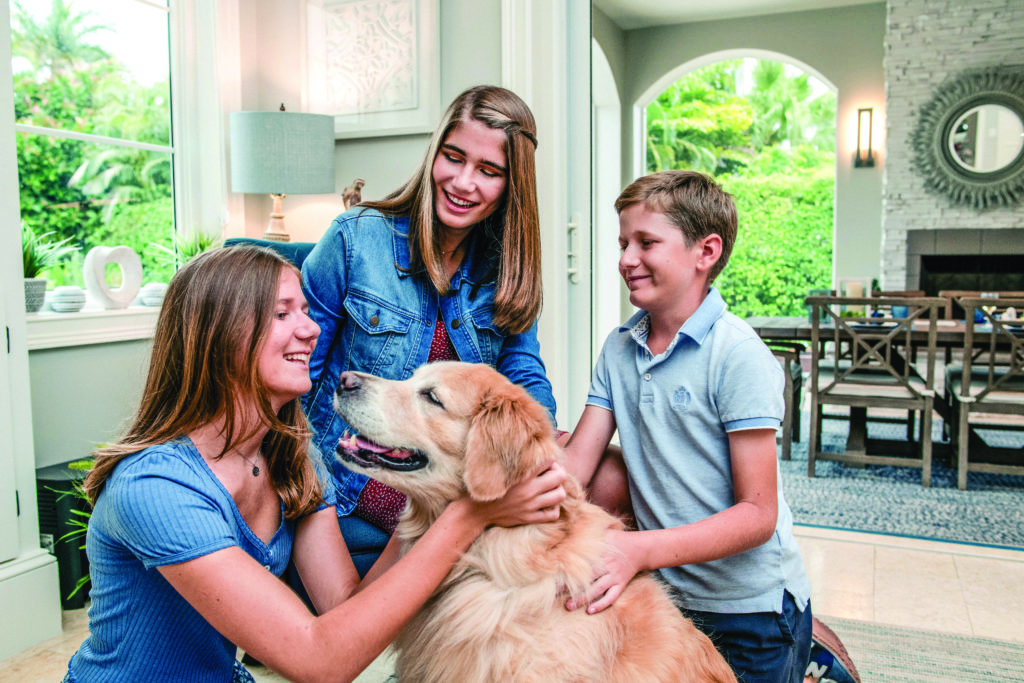
To say she has done a complete 180 over the past three years is an understatement. It would not be hyperbole to call her one of the leading activists and champions of FSHD research and fundraising in the United States. This once-closed-off girl has gone from not wanting to even speak privately about her disorder to founding the Southwest Florida chapter of the FSHD Society that now has about 15 active members with an impact that reaches far beyond the region.
When she held the very first meeting in her family room two years ago, it was the first time she had met others living with FSHD. “The first patient arrived, and I felt this strength—an electric strength—and it kept building. It was really cool to hear how everyone had different life stories, had been diagnosed at different ages, had different first symptoms, but we all had the same disorder,” Heloise says. “I remember one patient came up to me and said, ‘This meeting really made a big impact on my life,’ and I was kind of taken aback. I was really stirred and moved.”
Building on that momentum, she launched the chapter’s first fundraiser, a Walk & Roll (the name is an inclusive nod to the many patients who use a wheelchair). Even that came with an adjustment—it was originally set to be a springtime concert featuring local musicians but the pandemic caused them to pivot to a virtual format. The chapter raised more than $64,000, the highest of any Walk & Roll in the nation, with 364 individual donors.
Continuing on that success, this year’s event is scheduled for September 18 at Baker Park. Heloise’s band will perform there, bringing an element of the original plan to the new format.
“Getting involved in the society has given her so much more self-confidence and growth. We are so proud of her,” Alex says. “We talk a lot about the dark days, but the great story about Heloise is that in the past two years she has bloomed—she has matured completely. We are in awe of what she has done.”
One aspect of Heloise’s awakening is the realization that there is real hope for a cure—or at least a promising treatment—that may be available by 2025. The work is centered on stopping the progression of the disorder. Multiple companies, from pharmaceutical giants to biotech startups, are in this race against time for patients like Heloise, with a phase 2 clinical trial underway from the Massachusetts-based Fulcrum Therapeutics. “We’re not going to get a cure if we just sit around and wait for a cure to come. We have to stand up emotionally and mentally so that we can stand up for those who can’t stand,” Heloise says.
To that end, she interned with a prominent Yale lab over the summer, using the new complete human genome (the full readout of our DNA, first published in 2000, was completed with the missing 8% of the genome in May) to study the gene responsible for FSHD and better understand the mechanisms causing the disorder. She also presented independent statistical research to the FSHD International Research Congress in June, a project she worked on with a clinician during her junior year of high school, in which she surveyed patients nationwide on sleep quality and found a direct relationship to pain. “If we find a treatment that affects pain, sleep quality could be affected too,” she says. “Sleep is really important for FSHD patients because it’s when muscles are restored and protected.”
Between all of that, she finds time to play in her band, participate in school musicals, be a member of the local Odyssey of the Mind team that competed in the World Finals in June and keep a schedule brimming with AP classes. Not to mention, she just volunteered to lead a project on youth involvement for the FSHD Society.
“Heloise wants to live her life 100%,” Anne says. “One of the biggest things she says is, ‘This disease doesn’t define me. It is part of me. It is my challenge, but it doesn’t define me.’”
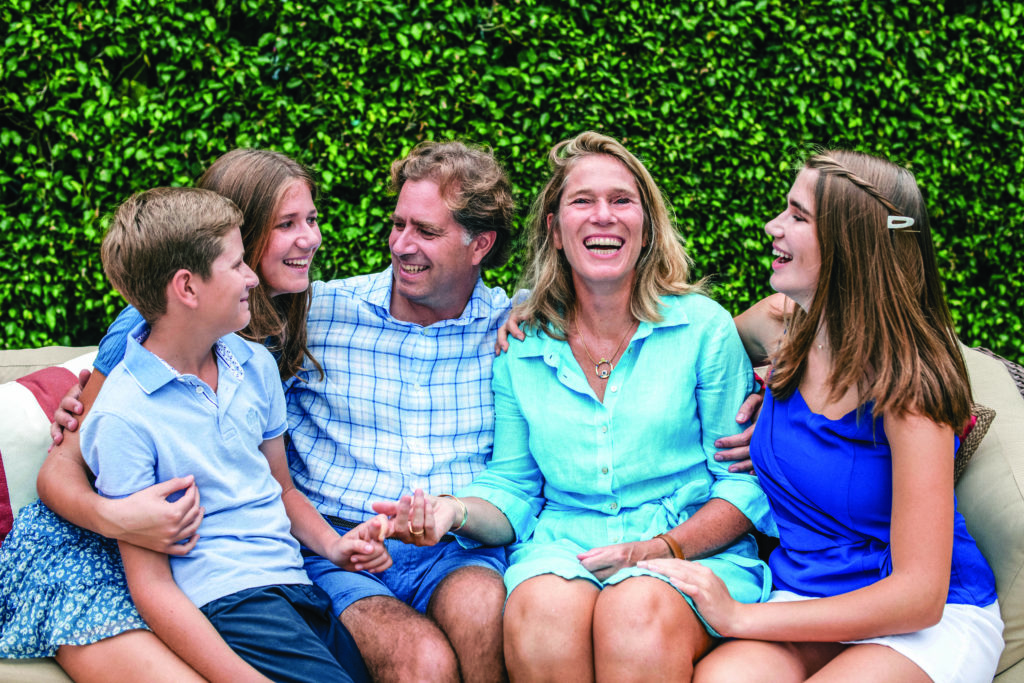
She does still have roadblocks. As she says, she may look completely normal, but she may wake up one day in unbearable pain and unable to move, or she may try to climb the stairs at her school instead of taking the elevator so as to avoid looking “lazy,” only to then feel her legs give out from under her. “Losing the small things is the most painful. Those are what make your life feel normal. Seeing the progress over the years and waiting for the next time something might be lost is the hardest thing to deal with,” Heloise says.
The uncertainty of FSHD is a big aspect of the disorder. Thinking to the future, she can’t predict whether she’ll progress one way or another: “People say it’s the mourning disease. You lose a set of abilities, wake up one day and you can’t do something anymore, whether it’s smiling, brushing your hair or walking up stairs.”
Always there to support her—and help her dream big—is her family. Anne and Alex’s goals for her near-term are to go to college and live independently. They, too, believe a cure is within grasp based on the trajectory of current research, and they will do everything they can to help Heloise make that a reality.
Heloise’s goals include one day becoming a pediatric neurologist. “I want to make sure no child hears that pain is due to their teenage imagination,” she says, recalling her painful misdiagnosis. She also thinks about being a college professor, starting a family and perhaps finding time to sing in the chorus of an opera. “My main goal is to be happy where I am, even before anything else, like having a successful career,” she says. “I’m a strong believer that you can find happiness wherever you are if you look for it.”
With the wings given to her by her family, the society she so tirelessly gives back to and the greater network of teachers, friends and fellow patients by her side, there’s no doubt for anyone who knows her that she’ll be able to do that—and then some.

